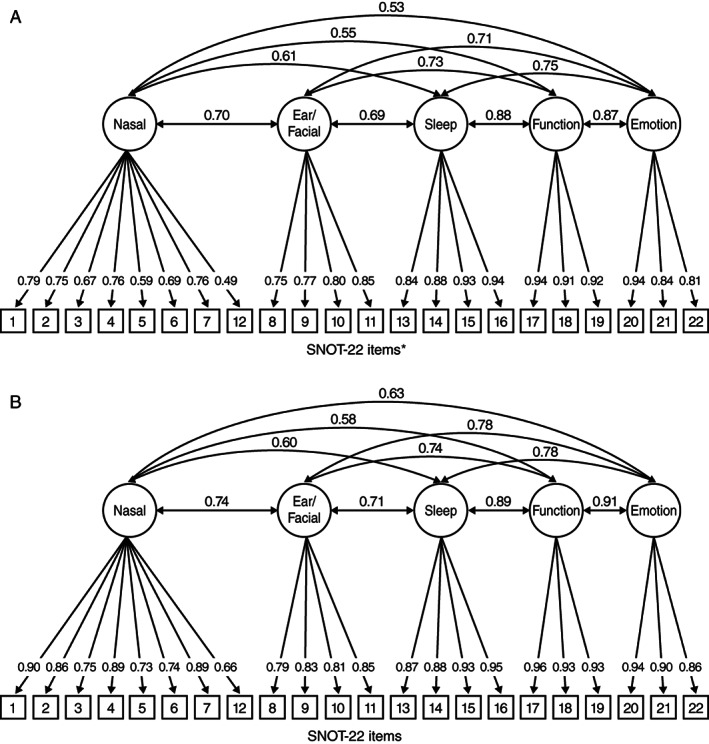Fig 1.

Five‐factor SNOT‐22 confirmatory factor analysis based on pooled phase 3 data at (A) baseline; (B) week 24. (A) *P < .01. Goodness‐of‐fit statistics for the five‐factor confirmatory factor analysis with no cross‐loading are as follows: CFI, 0.962; TLI, 0.956; RMSEA, 0.094 (95% CI 0.089–0.098). Minor modification to allow item 16 to load on both the Sleep and Function domains reduced RMSEA to 0.076 (0.071–0.081), with the strongest loading of this item (0.487) still on the Sleep domain. Items: 1. need to blow nose; 2. nasal blockage; 3. sneezing; 4. runny nose; 5. cough; 6. post‐nasal discharge; 7. thick nasal discharge; 8. ear fullness; 9. dizziness; 10. ear pain; 11. facial pain/pressure; 12. decreased sense of smell/taste; 13. difficulty falling asleep; 14. wake up at night; 15. lack of a good night's sleep; 16. wake up tired; 17. fatigue; 18. reduced productivity; 19. reduced concentration; 20. frustrated/restless/irritable; 21. sad; 22. embarrassed. (B) Goodness‐of‐fit statistics for the five‐factor confirmatory factor analysis with no cross‐loading are as follows: CFI, 0.975; TLI, 0.971; and RMSEA, 0.084 (95% CI, 0.079–0.089). Items: 1. need to blow nose; 2. nasal blockage; 3. sneezing; 4. runny nose; 5. cough; 6. post‐nasal discharge; 7. thick nasal discharge; 8. ear fullness; 9. dizziness; 10. ear pain; 11. facial pain/pressure; 12. decreased sense of smell/taste; 13. difficulty falling asleep; 14. wake up at night; 15. lack of a good night's sleep; 16. wake up tired; 17. fatigue; 18. reduced productivity; 19. reduced concentration; 20. frustrated/restless/irritable; 21. sad; 22. embarrassed. CFI = comparative fit index; CI = confidence interval; RMSEA = root mean square error of approximation; SNOT‐22 = 22‐item Sinonasal Outcome Test; TLI = Tucker‐Lewis index.
